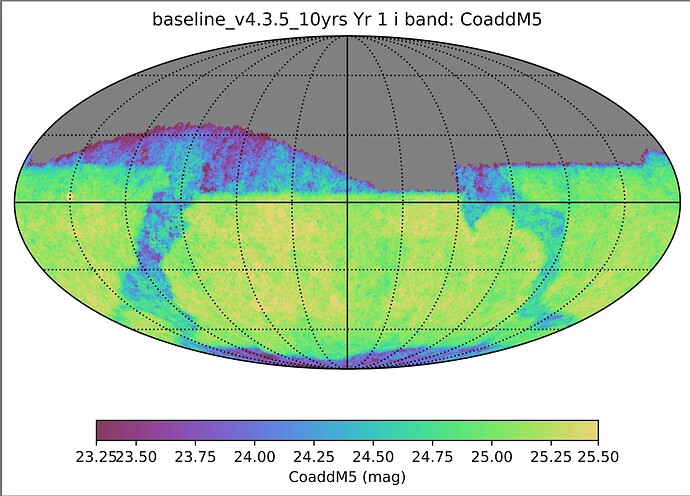Hello, first of all if you know somebody else that would answer to this question , please give me his name and email address!
I’m very interested in the LSST. And I need to know if the Pisces/Cetus sector will be surveyed at the beginning, which is scheduled for November.
Or if we will have to wait until July-August 2026, when this sector will appear again in the night sky and the Survey will cover the entire planned area, not just a reduced area from which the Pisces/Cetus sector would have been excluded!
Because, I found an article from the University of Arizona undated, so perhaps obsolete, (besides, they are the only ones to talk about it on the entire internet, while the Vera Rubin website only talks about a beginning that will be only limited during the first 6 months by 50% of image quality and speed, but does not mention a reduced area explored! : Ref: “Criteria to start the legacy survey”: https://rtn-093.lsst.io ), so I was talking about the article from Arizona University which announces that in the first year (“Year 1 data”) there will only be 15,000 deg^2 covered… …while the complete territory is 18,000 deg^2 for the main survey (southern sky) + 4,000 deg^2 (according to my estimate) of specific regions like the northern ecliptic, the galactic plane, the Magellanic Clouds, etc. = total 22,000 deg^2! 7,000 deg^2 are missing!
“Rubin Observatory’s Legacy Survey of Space and Time (LSST) will commence science operations for the main survey in 2024, imaging more than 18,000 square degrees in 6 optical bands to an unprecendented depth over the following 10 years. Already the LSST Year 1 data will cover ~15,000 deg^2 to i-mag 24.3, a fantastic data set for cosmological discoveries.”
Note that they use the future tense to talk about events taking place in 2024! (“LSST will commence science operations in 2024…”). So this article must be out of date by now… But, who knows?
Because, as I said, on the Vera Rubin Telescope website (and anywhere else), there’s no information about a possible reduction in the observation area in the first year!
So I ask you. Is this correct or not? And if so, in that case will the Pisces/Cetus area be excluded, even partially, at the beginning of the survey?
Cetus and Southern Pisces are in the southern sky, and therefore will be part of the Main Survey (in orange on the sky map), but Northern Pisces is outside it (Northern Hemisphere Sky, northern ecliptic [“special region”] in blue):
The sector Cetus/Pisces is shown as a green square :
It would be great if you had this information, as I have high expectations for this survey in that sector, and I really wish to know if we have to wait 5 months or 14 months !!
With all my gratitude!
PS : and also, I didn’t understand well if the first 6 months it’s absolutely sure that the image quality will be reduced of 50% (0.70" instead of 0.35"), from what I read in "Criteria to start the legacy survey ": https://rtn-093.lsst.io section 3 “Criteria to begin the LSST” page 5 :
“Beginning the scheduled observations no sooner that the system can run at 50% effective speed and with image quality (system contribution) below 0.7” is accpetable as long as a clear path to improved performance exists. We assume the path to improvment will arrive at nominal effectiveness (speed 1.0, Image Quality 0.35") within 6 months of the start of survey. Indeed, the ComCam campaign in Q1 FY24 showed the system contribution to image quality is likely as good 0.4" already without full control over the in-dome environment (See On behalf of Rubin Observatory Project, SITCOMTN-149, section 2.2)."
What does it mean ? That they will absolutely respect a protocol where the 6 first months the IQ (Image Quality) is maintained at only 0.70" or is it that 0.70" is only the limit to reach to start the survey, but that if it’s possible they will use a better IQ from the beginning ??
That’s also something very important for me as I wish to know what kind of size of possible dwarf planets they could detect in this sector. Typically, some dwarf planets of a similar size than Pluto or Eris (~2000km), but at a farther distance (130-180 AU, instead of 30-70AU for Pluto and 130AU for Eris). An object of around 21-22 apparent magnitude, at a distance of around 140-170AU.
So, if it’s not possible with an IQ of 0.70" and that we will have to wait obligatory 6 months for the IQ to increase, then that means that I’ll have, also in that case, to wait until summer 2026…
So any opinion on that too is very welcome !!![]()
Thank you so much to have given me some of your precious time !
Sincerely
Raoul
